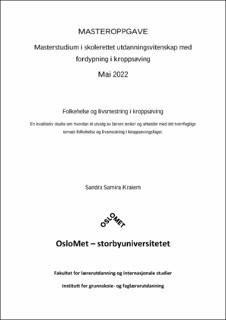Folkehelse og livsmestring i kroppsøving. En kvalitativ studie om hvordan et utvalg av lærere tenker og arbeider med det tverrfaglige temaet folkehelse og livsmestring i kroppsøvingsfaget
Master thesis
Published version
Permanent lenke
https://hdl.handle.net/11250/3048124Utgivelsesdato
2022Metadata
Vis full innførselSamlinger
Sammendrag
Hensikten med dette forskningsprosjektet har vært å undersøke hvordan et utvalg av lærere tenker og arbeider med det nye tverrfaglige temaet «folkehelse og livsmestring» i kroppsøvingsfaget. Problemstillingen er som følger: Hvordan tenker og arbeider et utvalg av lærere med det nye tverrfaglige temaet folkehelse og livsmestring i kroppsøvingsfaget? Semistrukturerte intervju ble gjennomført med fem lærere som underviser på ungdomstrinnet ved tre skoler i Viken. Det ble foretatt et strategisk utvalg av lærere fra de ulike skolene. Alle lærerne som deltok i forskningsprosjektet, hadde formell kompetanse i kroppsøving og underviste i faget. Datamaterialet ble bearbeidet gjennom tematisk analyse, og blir presentert gjennom tre overordnede temaer:
• Lærernes oppfatning av tematikken
• Arbeidet
• Utfordringer knyttet til planlegging og undervisning
Teorien tar utgangspunkt i Antonovskys helseforståelse, med både det salutogene og patogene perspektivet, samt didaktikk og den didaktiske trekanten. I tillegg trekker jeg inn historisk bakgrunn og utvikling av kroppsøvingsfaget og forskning knyttet til skolen og samfunnet. Dette inkluderer også beskrivelser av fagfornyelsen og det tverrfaglige temaet folkehelse og livsmestring. Funn fra undersøkelsen viser at de at utvalgte informantene tenker at det tverrfaglige temaet folkehelse og livsmestring handler om både fysisk og psykisk helse. Flesteparten av informantene snakket mer om helseaspektet og psykisk helse da de fikk spørsmål om hva folkehelse og livsmestring betyr i kroppsøvingsfaget. Fysisk aktivitet og trening blir nevnt som en naturlig del av faget i samtalene. Flere av informantene gav uttrykk for at det tverrfaglige temaet har kommet inn i ny læreplan for å skape mer bevissthet rundt det å ta vare på seg selv. Dette kan ses i sammenheng med folkehelse. Funnene viser at samtlige informanter praktiserer folkehelse og livsmestring i kroppsøving. Selv om hovedinntrykket er at informantene arbeider med folkehelse og livsmestring i kroppsøving relativt likt, kan innholdet i det de formidler gjennom ord og utrykk og det praktiske arbeidet variere. Funnene viser at noen informanter opplever at de ikke har fått nok tid til å jobbe med eller sette seg inn i det tverrfaglige temaet folkehelse og livsmestring, mens andre opplever ingen utfordringer knyttet til hverken planlegging eller gjennomføring av undervisning. Flere informanter gir uttrykk for at det kan være vanskelig å balansere hvor mye av undervisningen i kroppsøving som skal være teori og hvor mye skal være aktivitet, og hvordan faget skal vurderes.
The purpose of this research project was to investigate how a selection of teachers think and work with the new interdisciplinary topic "health and life skills" in physical education (P.E.). Therefore, the research problem is as follows: How does a selection of teachers think and work with the new interdisciplinary topic “health and life skills” in physical education? Semi-structured interviews were conducted with five teachers that teach at the lower secondary level, at three different schools in Viken. A strategic selection of teachers from the various schools were made. All teachers that participated in this research project has a formal education within the P.E. subject and actively teaches the subject. The data was analyzed using thematic analysis, and is presented as three main topics:
• Teachers' perception of the topic
• Work
• Challenges related to planning and teaching
The theory is based on Antonovsky's understanding of health, with both the salutogenic and the pathogenic perspective, as well as didactics and the didactic triangle. In addition, historical background on the development of physical education and research related to school and society is included. In addition to this, the subject renewal and the interdisciplinary topic of health and life skills is described. Findings from the survey shows that the selected participants think that the interdisciplinary topic of health and life skills are about both the physical as well as the mental health. Most of the participants spoke more about the health aspect and mental health when they were asked about what health and life skills mean in physical education. Both physical activity as well as training is mentioned as a natural part of the subject in the interview. Several of the participants expressed that the interdisciplinary topic of health and life skills has been entered to the curriculum to create more awareness about taking care of oneself. This can be seen in the context of public health. The findings show that all participants practice health and life skills in P.E. Although the main impression is that the participants work with the interdisciplinary topic of health and life skills in physical education relatively similarly, the content of what they convey through words and expressions as well as the practical work can vary. The findings show that some participants feel that they have not had enough time to work with or familiarize themselves with the interdisciplinary topic of health and life skills, while others experience no challenges related to either planning or implementation of these topics to their lessons. Several participants express that it can be difficult to balance how much of the P.E. lessons should be theory and how much should be activity, and how the subject should be assessed.
